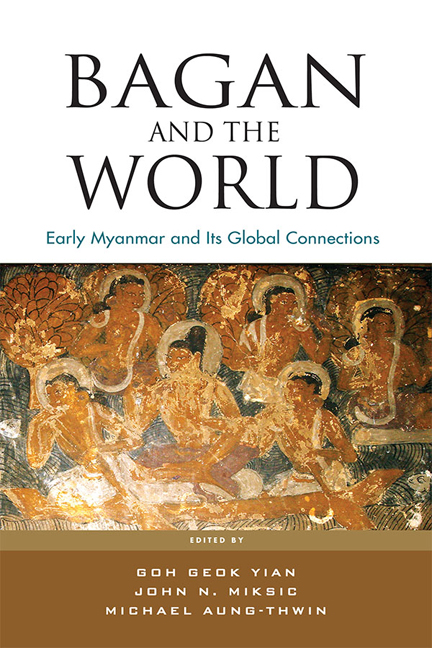Book contents
- Frontmatter
- Contents
- Preface
- Contributors
- 1 Keynote: The Myth of “Splendid Isolation”
- 2 Analysis of Construction Technologies in Pyu Cities and Bagan
- 3 Khraung-kaik Pitaka-taik: 16th-Century Repositories for Buddhist Scriptures in Mrauk-U
- 4 Religious Symbols as Decorations on the Sikhara of Ancient Monuments in the Late Bagan Period
- 5 The Viṣṇu on Garuḍa from the Nat Hlaung Kyaung Temple, Bagan
- 6 A Thousand Years before Bagan: Radiocarbon Dates and Myanmar's Ancient Pyu Cities
- 7 Ta Mok Shwe-Gu-Gyi Temple Kyaukse and Bagan
- 8 Silver Links! Bagan–Bengal and Shadowy Metal Corridors: 9th to 13th Centuries
- 9 Positioning Bagan in the Buddhist Ecumene: Myanmar's Trans-Polity Connections
- 10 Orthogeneity, Settlement Patterns and Earthenware Pottery Distribution in Bagan
- Index
- Miscellaneous Endmatter
10 - Orthogeneity, Settlement Patterns and Earthenware Pottery Distribution in Bagan
Published online by Cambridge University Press: 01 February 2018
- Frontmatter
- Contents
- Preface
- Contributors
- 1 Keynote: The Myth of “Splendid Isolation”
- 2 Analysis of Construction Technologies in Pyu Cities and Bagan
- 3 Khraung-kaik Pitaka-taik: 16th-Century Repositories for Buddhist Scriptures in Mrauk-U
- 4 Religious Symbols as Decorations on the Sikhara of Ancient Monuments in the Late Bagan Period
- 5 The Viṣṇu on Garuḍa from the Nat Hlaung Kyaung Temple, Bagan
- 6 A Thousand Years before Bagan: Radiocarbon Dates and Myanmar's Ancient Pyu Cities
- 7 Ta Mok Shwe-Gu-Gyi Temple Kyaukse and Bagan
- 8 Silver Links! Bagan–Bengal and Shadowy Metal Corridors: 9th to 13th Centuries
- 9 Positioning Bagan in the Buddhist Ecumene: Myanmar's Trans-Polity Connections
- 10 Orthogeneity, Settlement Patterns and Earthenware Pottery Distribution in Bagan
- Index
- Miscellaneous Endmatter
Summary
On the surface, Southeast Asian archaeology presents an extreme example of the dichotomy between the theoretical extremes of the orthogenetic and heterogenetic types of city. The remains of major monumental complexes such as Angkor, Borobudur/Prambanan and Bagan contrast sharply with the remains of trading port-cities such as Palembang, Barus and Singapore. This apparently simple picture, however, begins to display more shades of grey the more one peers beneath the surface, as further exploration begins to provide more detailed information about the lives of these ancient cities. Research at the site of Trowulan, east Java, in the early 1990s necessitated a revision of the previous assumption that Majapahit's 14th-century capital was merely a complex of royal and religious buildings. Surface survey in the wake of large-scale looting of bricks for modern construction revealed dense scatters of pottery, both local and foreign. This pottery demonstrated the existence of numerous occupations and a dense population.
Archaeological observation at the sites of Bagan and Sriksetra (Pyay, Prome) is beginning to shed light on the distribution of population and range of economic activity at these sites. The occupations at the two sites overlap to a considerable extent, indicating that for a period of time they were linked in a complex economic relationship which written materials hint at but do not describe in detail.
Data obtained from the study of pottery distribution patterns is capable of measuring the degree of socio-economic complexity at a site. Preliminary analysis of recent discoveries indicates that Sriksetra and Bagan, like Trowulan, may have been hinterland capitals with some heterogenetic as well as orthogenetic characteristics. Preliminary pottery data indicates that Sriksetra and Bagan were similar but differed in several significant aspects, including internal settlement patterns and presence or absence of Chinese ceramics.
While our knowledge of pre-modern interaction between Southeast Asia and its neighbours to the east and west is increasing, we still know little of the interaction between Southeast Asian societies during this period. Stylistic studies of art suggest that Southeast Asian societies interacted and exchanged cultural and artistic traits to a relatively high degree, as well as economic commodities (Brown 1994).
- Type
- Chapter
- Information
- Bagan and the WorldEarly Myanmar and Its Global Connections, pp. 198 - 219Publisher: ISEAS–Yusof Ishak InstitutePrint publication year: 2017



